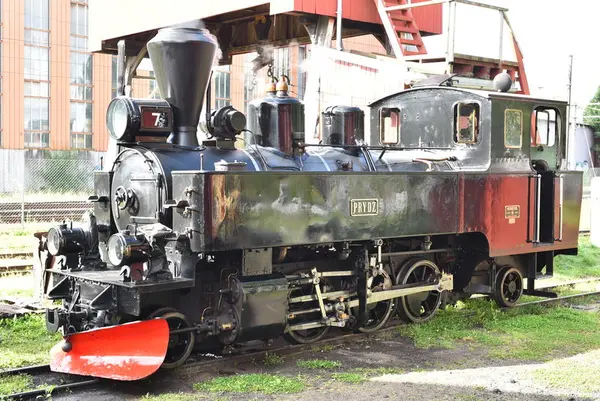Our pride is of course our steam locomotives. We untiringly work on these fantastic machines to keep them in tip-top condition.
You can read about them here, but to really get to know our locomotives, you need to come and smell the oil and steam, hear the noise of the pistons and feel how the train builds up energy as the pressure rises.
-
Foto: Ragnar Andenæs
Setskogen
Steam locomotive XXVIII 4 Setskogen-Hartmann 1909 is a twin cylinder steam engine with a wet steam engine, delivered by Hartmann in 1909.
A locomotive from the American producer Baldwin was delivered to Høland Railway to celebrate its opening in 1898. It received the number 3 and name Høland. This locomotive was much used despite the boiler having too low output. After a few years, Urskog-Hølandsbanen wanted to build a new locomotive and it was decided that they would build one with the same dimensions and wheel set up as locomotive number 3. The new locomotive was delivered by Hartmann, and received the number 4 and name Setskogen. The locomotive was a successful construction and would become a template for the later locomotive deliveries to the Urskog-Hølandsbanen.
Setskogen was in use until the Urskog-Hølandsbanen was shut down in 1960. The locomotive has been renovated back to its delivery state and got a new boiler in 1985.
Technical data:
- Locomotive number: 4
- Machine type: Twin-cylinder wet steam
- Axel set up: 1’C’1
- Cylinder bore: 260 mm
- Cylinder stroke: 400 mm
- Grate surface: 0.67m2
- Boiler pressure: 12kg/m2
- Heat surface, total: 36.33m2
- Wheel diameter: 814mm
- Water storage: 2.1 tonnes
- Coal storage: 0.5 tonnes
- Service weight: 19.6 tonnes
- Material weight: 15.3 tonnes
- Maximum cylinder pressure force: 2400kp
-
Foto: Erik Borgersen
Høland
Damplokomotiv XXIXa 6 Høland-Hartmann 1925 is a two cylinder steam locomotive with a superheater engine.
The experiences with locomotive nr 5, which the Urskog-Høland Railway (Urskog-Hølandsbanen) received from Hartmann in 1924, were so good that the railway decided to purchase another locomotive which was delivered the year afterwards. The new locomotive received the number 6 and took over the name Høland from locomotive nr 3, which was decommissioned.
Høland drove on the Urskog-Høland Railway (Urskog-Hølandsbanen) until it was shut down in 1960. The locomotive has been renovated back to its delivery state and got a new boiler in 1985.
Technical data:
- Locomotive number: 6
- Machine type: Twin-cylinder superheater
- Axel set up: 1’C’1
- Cylinder bore: 260 mm
- Cylinder stroke: 400 mm
- Grate surface: 0.67m2
- Boiler pressure: 12kg/m2
- Heat surface, total: 41.4m2
- Wheel diameter: 824mm
- Water storage: 2.1 tonnes
- Coal storage: 0.5 tonnes
- Service weight: 20.5 tonnes
- Material weight: 16.2 tonnes
- Maximum cylinder pressure force: 3200kp
-
Foto: Erik Borgersen
Prydz
Steam locomotive XXIXb 7 Prydz-Henchel 1950 is a twin cylinder steam locomotive with a superheater engine.
The Urskog-Høland Railway (Urskog-Hølandsbanen) was nationalised in 1945. After the second world war the stock was worn down and NSB purchased a new steam locomotive similar to numbers 5 and 6. Since Hartmann no longer existed, the new locomotive was built by Henchel, but the specifications were the same as the two previous locomotives. The new locomotive received the number 7 and was delivered in 1950. It was decided to name this locomotive after the Railway’s long term leader Eigil Prydz, in honour of his hard work in keeping Tertitten going through many difficult years.
Prydz was the last steam locomotive delivered to any Norwegian railway and is Norway’s only working steam locomotive with a firebox made of copper plate.
Prydz was in use until the Urskog-Høland Railway (Urskog-Hølandsbanen) was shut down in 1960. After the shut down, the locomotive was transported to the Norwegian Railway Museum. While here, the locomotive was altered for oil-firing and it drove for many years before it was decommissioned in 1983, when the restorations of Urskog were complete. Between the years 1987-1991 the locomotive received a complete overhaul and was thereafter set in use on the Urskog-Høland Railway (Urskog-Hølandsbanen).
Technical data:
- Locomotive number: 7
- Machine type: Twin-cylinder wet steam
- Axel set up: 1’C’1
- Cylinder bore: 260 mm
- Cylinder stroke: 400 mm
- Grate surface: 0.67m2
- Boiler pressure: 12kg/m2
- Heat surface, total: 41.4m2
- Wheel diameter: 824mm
- Water storage: 2.1 tonnes
- Coal storage: 0.5 tonnes
- Service weight: 20.5 tonnes
- Material weight: 16.2 tonnes
- Maximum cylinder pressure force: 2700kp


